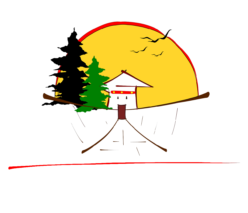He looks like a demon from an especially bad nightmare: a blue monster with horns and three eyes on his head, which is in turn topped by another eight heads, culminating in a strangely serene Buddha face. His main hands hold a chopper and a cup made from a human skull. Thirty-two other hands wield an array of weapons. He wears a belt of human heads and his 16 feet trample small humans and animals. A nimbus of orange flames surrounds his body. Even his penis is angry, brandished like an avenging sword.
It’s a shocking and fascinating image, not one immediately likely to conjure up the peaceful kingdom of Bhutan, a Switzerland-size country in the Himalayas that extols “gross national happiness” rather than gross national product as a measure of its wealth and development.
Yet the 18th-century thangka (painting) opens a window on the cosmology of Bhutan, something of a hermit nation, where foreigners were not permitted to enter until 1974 and even now aren’t encouraged to visit very long or range widely. Most of Bhutan’s 700,000 people practice Vajrayana Buddhism, in which wrathful deities such as Mr. Blue (or — to give him his rightful, if hard to pronounce, name — Vajrabhairava) are protectors of the faith. He also symbolizes the struggle to tame negative impulses — a critical part in every person’s journey to transcend the prison of the self.
The thangka is one of many striking artifacts on offer at a rare exhibit of more than 150 works from Bhutan, most drawn from working monasteries and few of which have ever left the country before. Organized by the Honolulu Academy of Arts, where the show opened, the exhibit is on view at the Asian Art Museum of San Francisco through May 10.
Two monks have accompanied the works and perform a ritual observance at an altar in the museum’s courtyard daily at 11 a.m. and 3 p.m. Dance is also an integral part of Bhutan’s religious practice, and videos of monks twirling in crimson robes play in each gallery.
Bhutan calls itself Druk Yul (Land of the Thunder Dragon), and the show is called “The Dragon’s Gift.” Thangkas, sculptures, votive decorations — gallery after gallery overflows with wondrous imagery that can seem both utterly alien to the Western tradition and yet remarkably familiar at the same time. A number of thangkas center on a bodhisattva (or enlightened being who delays entering Nirvana in order to help others) displaying great poise amid the chaos of the world, while in the lower reaches of the picture devils pull people toward a violent netherworld. Looking at several of these, I kept being reminded both of Bosch and the Last Judgment scenes that are a staple of Christian iconography.
Many of the thangkas fairly drip with gore. Flayed human skins abound, warriors — striking a pose familiar to anyone who practices yoga — stomp on enemies, a devil rides a mount across a sea of blood. One of the stand-out images is an iron statue of Vajrakila, a multifaced warrior with outstretched wings, his body ending in a dagger that plunges into the middle of a prone figure.
Such dualities reflect not only Buddhist thought but also Bhutan’s own history. Bhutan didn’t exist as a unified state until the 17th century, when a warrior-monk named Ngawang Namgyal built a network of fortress-monasteries, called dzongs, which to this day are the religious and political centers of the country. Most of the art on display comes from these dzongs.
Ngawang Namgyal (also called Zhabdrung, or At Whose Feet One Submits) appears in several thangkas and statues, including a magnificent woodcarving that portrays the monk sitting cross-legged in meditation, his distinctive tapering beard painted blue, as is his ceremonial cap. His eyes hover half-closed, looking inward. It was apparently a typical pose. Zhabdrung once went three years without talking. After he died, the country’s rulers kept the news from the public for 54 years.
Despite the fierceness of much of the imagery, the overriding tone that emerges is one of serenity. One beautiful 19th-century thangka depicts Avalokitesvara, the Lord of Compassion, who despaired over his inability to save all beings. The painting shows him after his head split into 11 pieces and he sprouted 1,000 arms — the better to help ease the suffering of the world. The arms radiate out in a kaleidoscope of hands and bejeweled wrists, a creamy white the dominant color, accented by a lush green landscape with flowers, deer, elephants and snow-topped peaks in the distance.
Avalokitesvara is my favorite bodhisattva. He cried when he realized how much unhappiness there was in the world. His tears created two goddesses: Green Tara and White Tara, helpmeets in his never-ending work.
A lovely Green Tara is portrayed in a gilt bronze image, which shows a well-built woman, her body adorned by turquoise dots, sitting on a lotus flower, her hands open and inviting, so too her legs. Long hair tumbles down her back. It’s an image that manages to be both provocative and pacific at the same time.
A gift, indeed.
By: Micahel J. Ybarra, San Francisco
Source: The Wall Street Journal
